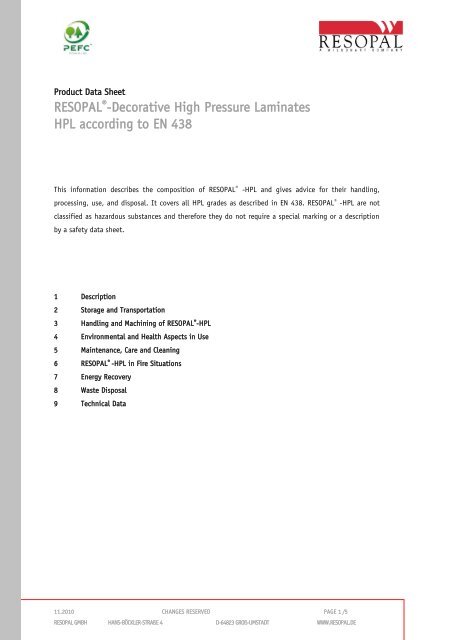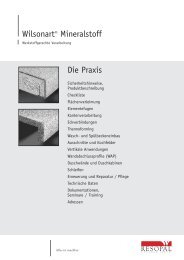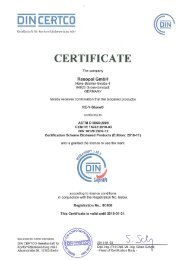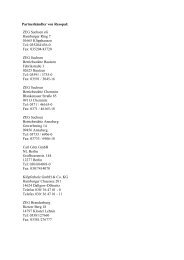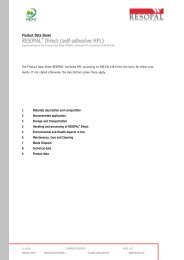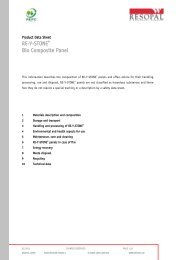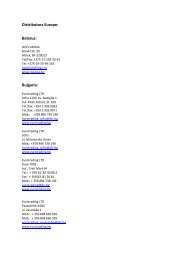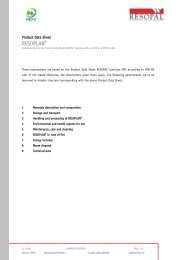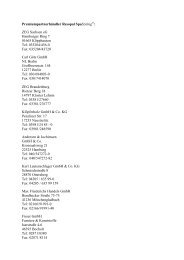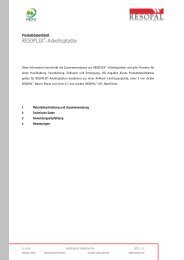RESOPAL®-Decorative High Pressure Laminates HPL according to ...
RESOPAL®-Decorative High Pressure Laminates HPL according to ...
RESOPAL®-Decorative High Pressure Laminates HPL according to ...
Create successful ePaper yourself
Turn your PDF publications into a flip-book with our unique Google optimized e-Paper software.
Product Data Sheet<br />
RESOPAL ® -<strong>Decorative</strong> <strong>High</strong> <strong>Pressure</strong> <strong>Laminates</strong><br />
<strong>HPL</strong> <strong>according</strong> <strong>to</strong> EN 438<br />
This information describes the composition of RESOPAL ® -<strong>HPL</strong> and gives advice for their handling,<br />
processing, use, and disposal. It covers all <strong>HPL</strong> grades as described in EN 438. RESOPAL ® -<strong>HPL</strong> are not<br />
classified as hazardous substances and therefore they do not require a special marking or a description<br />
by a safety data sheet.<br />
1 Description<br />
2 S<strong>to</strong>rage and Transportation<br />
3 Handling and Machining of RESOPAL ® -<strong>HPL</strong><br />
4 Environmental and Health Aspects in Use<br />
5 Maintenance, Care and Cleaning<br />
6 RESOPAL ® -<strong>HPL</strong> in Fire Situations<br />
7 Energy Recovery<br />
8 Waste Disposal<br />
9 Technical Data<br />
11.2010 CHANGES RESERVED PAGE 1 /5<br />
RESOPAL GMBH HANS-BÖCKLER-STRAßE 4 D-64823 GROß-UMSTADT WWW.RESOPAL.DE
1 Description<br />
The materials referred <strong>to</strong> are high pressure decorative laminates (<strong>HPL</strong>) <strong>according</strong> <strong>to</strong> the European<br />
Standard EN 438 and <strong>to</strong> ISO 4586.<br />
RESOPAL ® -<strong>HPL</strong> are sheets consisting of layers of cellulose fibrous material (normally paper) impregnated<br />
with thermosetting resins and bonded <strong>to</strong>gether in a high pressure process. The process,<br />
defined as a simultaneous application of heat ( 120 °C) and high specific pressure<br />
( 5 MPa), provides flowing and subsequent curing of the thermosetting resins <strong>to</strong> obtain a homogenous<br />
non-porous material (> 1,4 g/cm³) with the required surface finish.<br />
Basically more than 60 % of the RESOPAL ® -<strong>HPL</strong> consist of paper and the remaining 30 <strong>to</strong> 40 %<br />
consist of cured phenol-formaldehyde resin for core layers and melamine-formaldehyde resin for<br />
the surface layer.<br />
Both resins belonging <strong>to</strong> the group of thermosetting resins are irreversibly interreacted through<br />
cross linked chemical bonds formed during the curing process producing a non-reactive, stable<br />
material with characteristics which are <strong>to</strong>tally different from those of its component parts.<br />
RESOPAL ® -<strong>HPL</strong> are supplied in sheet form in a variety of sizes, thicknesses and surface finishes.<br />
Where improved fire retardance is required, the laminate core may be treated with an additive<br />
which does not contain halogens.<br />
2 S<strong>to</strong>rage and Transportation<br />
S<strong>to</strong>rage and transportation should be carried out in accordance with the General Processing<br />
Recommendations for RESOPAL ® -<strong>HPL</strong>; no special precautions need <strong>to</strong> be taken.<br />
For transportation, RESOPAL ® -<strong>HPL</strong> is classified as a non-hazardous product; no labeling is required.<br />
3 Handling and Machining of RESOPAL ® -<strong>HPL</strong><br />
The usual safety requirements of fabrication and machining should be observed with regard <strong>to</strong><br />
dust extraction, dust collection, and fire precautions.<br />
Because of the possibility of sharp edges protective gloves should always be worn when handling<br />
laminates. The contact with dust from RESOPAL ® -<strong>HPL</strong> does not present any special problems,<br />
however a small percentage of personnel may be sensitive or even allergic <strong>to</strong> machining<br />
dust in general.<br />
4 Environmental and Health Aspects in Use<br />
<strong>Decorative</strong> laminates are cured and therefore chemically inert.<br />
RESOPAL ® -<strong>HPL</strong> formaldehyde emission level is far below the limit for wood based materials. Due<br />
<strong>to</strong> their very low permeability RESOPAL ® -<strong>HPL</strong> bonded <strong>to</strong> wood based substrates act as a barrier<br />
against possible formaldehyde emissions coming from the substrates. There is no migration affecting<br />
foodstuffs and, consequently, RESOPAL ® -<strong>HPL</strong> are approved for contact with foodstuffs.<br />
The decorative surfaces are resistant <strong>to</strong> common household solvents and chemicals and have<br />
therefore been used for many years in applications where cleanliness and hygiene are important.<br />
The non-porous RESOPAL ® -<strong>HPL</strong> surface and edges are easy <strong>to</strong> disinfect with hot water, steam<br />
and all types of disinfectants used in hospitals and other commercial facilities.<br />
11.2010 CHANGES RESERVED PAGE 2 /5<br />
RESOPAL GMBH HANS-BÖCKLER-STRAßE 4 D-64823 GROß-UMSTADT WWW.RESOPAL.DE
<strong>HPL</strong> is an article and not a chemical substance and therefore REACH does not apply. Never the<br />
less it is important <strong>to</strong> ensure an information exchange with the raw material suppliers on<br />
REACH relevant substance properties.<br />
5 Maintenance, Care and Cleaning<br />
As RESOPAL ® -<strong>HPL</strong> do not suffer from corrosion and oxidation, they do not need any further surface<br />
protection (lacquers or paints).<br />
All decorative RESOPAL-surfaces can be cleaned with a mild soap solution. Hard contaminations<br />
are usually removed by means of solvents. Don’t use any abrasive agents (e.g. scouring powder).<br />
6 RESOPAL ® -<strong>HPL</strong> in Fire Situations<br />
<strong>Laminates</strong> are difficult <strong>to</strong> ignite and have properties that retard "spread of flame", thus prolonging<br />
evacuating time.<br />
Due <strong>to</strong> incomplete burning, as with many organic materials, hazardous substances are <strong>to</strong> be<br />
found in the smoke. However, <strong>HPL</strong> are capable of meeting the best performance for organic surfacing<br />
materials specified in the French standard NFF 16101 (= at least class F2 for smoke density<br />
and <strong>to</strong>xicity).<br />
In dealing with fires involving laminates the same fire fighting techniques should be employed<br />
as with other wood based building materials.<br />
7 Energy Recovery<br />
On account of their high calorific value (18 - 20 MJ/kg) 1) RESOPAL ® -<strong>HPL</strong> are ideal for thermal<br />
recycling. When burnt completely at 700 °C, <strong>HPL</strong> produce water, carbon dioxide and oxides of<br />
nitrogen. Therefore RESOPAL ® -<strong>HPL</strong> comply e. g. with paragraph 6 of the economic law of circular<br />
flow (Kreislaufwirtschaftsgesetz).<br />
Well controlled burning processes are achieved in modern, officially approved industrial incinera<strong>to</strong>rs.<br />
Ashes of this process can be brought <strong>to</strong> controlled waste disposal sites.<br />
8 Waste Disposal<br />
RESOPAL ® -<strong>HPL</strong> can be brought <strong>to</strong> controlled waste disposal sites <strong>according</strong> <strong>to</strong> current national<br />
and/or regional regulations.<br />
1 For comparison: Calorific value of fuel oil: 39 - 42 MJ/kg, of hard coal: 28 - 31 MJ/kg<br />
11.2010 CHANGES RESERVED PAGE 3 /5<br />
RESOPAL GMBH HANS-BÖCKLER-STRAßE 4 D-64823 GROß-UMSTADT WWW.RESOPAL.DE
9 Technical Data<br />
9.1 Physical/chemical characteristics<br />
9.1.1 Physical state Solid sheets<br />
9.1.2 Density 1.4 g/cm 3<br />
9.1.3 Solubility Insoluble in water, oil, methanol, diethyl ether, n-octanol,<br />
ace<strong>to</strong>ne<br />
9.1.4 Boiling point None<br />
9.1.5 Evaporation rate None<br />
9.1.6 Melting point RESOPAL ® -<strong>HPL</strong> do not melt<br />
9.1.7 Calorific value 18 - 20 MJ/kg<br />
9.1.8 Heavy Metals RESOPAL ® -<strong>HPL</strong> do not contain <strong>to</strong>xic compounds of antimony,<br />
Heavy metals barium, cadmium, chromium III , chromium VI , lead,<br />
mercury, selenium.<br />
9.2 Stability and reactivity data<br />
9.2.1 Stability RESOPAL ® -<strong>HPL</strong> are stable; they are not considered <strong>to</strong> be reactive<br />
or corrosive.<br />
9.2.2 Hazardous reactions None<br />
9.2.3 Material incompatibility Strong acids or alkaline solutions will stain the surface<br />
9.3 Fire and explosion data<br />
9.3.1 Ignition temperature Approx. 400 °C<br />
9.3.2 Flash point None<br />
9.3.3 Thermal decomposition Possible above 250 °C. Depending on the burning conditions<br />
(temperature, amount of oxygen, etc.) <strong>to</strong>xic gases may be<br />
emitted, e. g. carbon monoxide, carbon dioxide, ammonia.<br />
<strong>HPL</strong> are classified safe when tested <strong>according</strong> <strong>to</strong> NF F 16 101<br />
9.3.4 Smoke and Toxicity <strong>HPL</strong> are classified F2 when tested <strong>according</strong> NF F 16 101.<br />
9.3.5 Flammability RESOPAL ® -<strong>HPL</strong> are not considered <strong>to</strong> be flammable. They will<br />
burn only in a fire situation, in presence of open flames.<br />
9.3.6 Extinguishing media RESOPAL ® -<strong>HPL</strong> are considered as class A material. Carbon<br />
dioxide, water spray, dry chemical foam can be used <strong>to</strong><br />
extinguish flames. Water dampens and prevents rekindling.<br />
Persons in fire situations should wear self breathing apparatus<br />
and fire protective clothing.<br />
9.3.7 Explosion hazards The machining, sawing, sanding and routing of RESOPAL ® -<strong>HPL</strong><br />
produce class ST-1 dust. Safety precautions and adequate<br />
ventilation must be observed <strong>to</strong> avoid airborne dust<br />
concentration.<br />
9.3.8 Explosion limits Dust levels should be kept below 30 mg/m 3 .<br />
11.2010 CHANGES RESERVED PAGE 4 /5<br />
RESOPAL GMBH HANS-BÖCKLER-STRAßE 4 D-64823 GROß-UMSTADT WWW.RESOPAL.DE
9.3.9 Protection against In the case of fire RESOPAL ® -<strong>HPL</strong> shall be treated as wood<br />
explosion and fire based materials.<br />
9.3.10 Electrostatic behavior It minimizes the generation of charge by contact-separation or<br />
rubbing with another material. It does not need <strong>to</strong> be earthed.<br />
Surface resistivity is between 10 9 – 10 12 ohms and a chargeability of<br />
V < 2 kV <strong>according</strong> <strong>to</strong> CEI IEC 61340-4-1 so that <strong>HPL</strong> are antistatic<br />
material.<br />
9.3.11 S<strong>to</strong>rage and transport RESOPAL ® -<strong>HPL</strong> are classified as non-hazardous for transportation<br />
purposes and there are no specific requirements.<br />
9.3.12 Machining Use gloves <strong>to</strong> protect from sharp edges and safety glasses <strong>to</strong> prevent<br />
eye injuries. No special working equipment is necessary, except<br />
protections <strong>to</strong> minimize dust exposure in case of sheet machining.<br />
9.3.13 Disposal considerations Waste material should be handled <strong>according</strong> <strong>to</strong> local regulations.<br />
Burning is permitted in approved industrial incinera<strong>to</strong>rs.<br />
9.3.14 Health information RESOPAL ® -<strong>HPL</strong> are not considered <strong>to</strong> be dangerous for humans<br />
and animals. There is no evidence of RESOPAL ® -<strong>HPL</strong> <strong>to</strong>xicological<br />
effects and eco-<strong>to</strong>xicity. RESOPAL ® -<strong>HPL</strong> surfaces are physiologically<br />
safe and approved for use in contact with foodstuffs <strong>according</strong> <strong>to</strong><br />
EN 1186.<br />
9.3.15 Working areas General dust regulations are applicable.<br />
9.3.16 Formaldehyde emission < 0.4 mg/h m 2 (tested <strong>according</strong> <strong>to</strong> EN 717-2)<br />
< 0.05 ppm (tested <strong>according</strong> <strong>to</strong> the WKI chamber method)<br />
9.3.17 Pentachlorophenol RESOPAL ® -<strong>HPL</strong> do not contain PCP (Pentachlorophenol).<br />
9.3.18 Additional remarks RESOPAL ® -<strong>HPL</strong> as received are solid sheets and there would not be<br />
any health hazards associated with them.<br />
All information is based on the current state of technical knowledge, but it does not constitute any form of guarantee. It is the<br />
personal responsibility of the user of the products described in this information leaflet <strong>to</strong> comply with the appropriate laws and<br />
regulations.<br />
11.2010 CHANGES RESERVED PAGE 5 /5<br />
RESOPAL GMBH HANS-BÖCKLER-STRAßE 4 D-64823 GROß-UMSTADT WWW.RESOPAL.DE


